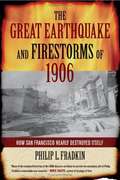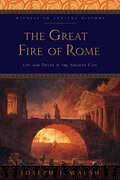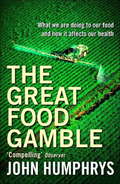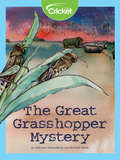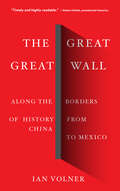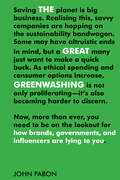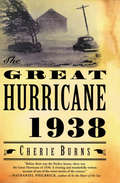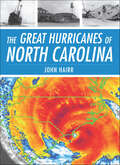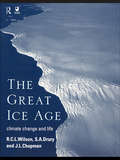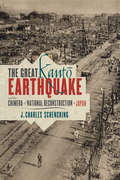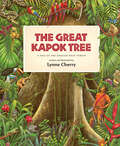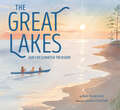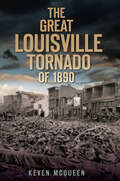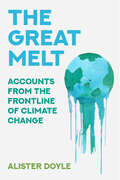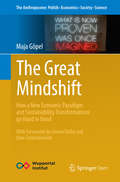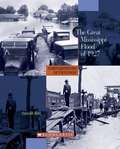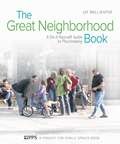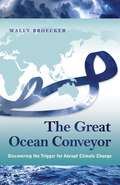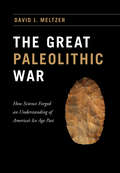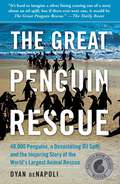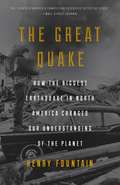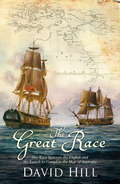- Table View
- List View
The Great Earthquake and Firestorms of 1906: How San Francisco Nearly Destroyed Itself
by Philip L. FradkinA gripping history of the 1906 San Francisco earthquake and fires, now with a new preface discussing how the 1906 earthquake compares to Hurricane Katrina.
The Great East Japan Earthquake Disaster and Population Changes: A population geography of the Tohoku Region, Japan (SpringerBriefs in Population Studies)
by Takashi AbeThe book aims to clarify from a demographic and geographical perspective how population trends of the Tohoku Region were changed as a result of the GEJED. The author shows how different the 2011 GEJED was from past disasters in this region with regard to the impacts on population change in the Tohoku Region. He explains how the recent disaster is different from past disasters, based on the theories of the first and second demographic transitions. He also clarifies the causality between the extent of housing damage and mortality through geographical analysis. Furthermore, this book shows how migration patterns were changed before and after the GEJED, and it identifies the differences between the areas affected by the tsunami and by the nuclear power plant accident.Investigating the GEJED as a case study, the book presents a method to analyze the relationship between natural disasters and population change. This book is especially useful for researchers inthe fields of disaster, environment, and population to better understand the relationship between the environment and population.
The Great Fire of Rome: Life and Death in the Ancient City (Witness to Ancient History)
by Joseph J. WalshA thrilling and momentous account of the Great Fire of Rome and how a modern city arose from its embers.Peril was everywhere in ancient Rome, but the Great Fire of 64 CE was unlike anything the city had ever experienced. No building, no neighborhood, no person was safe from conflagration. When the fire finally subsided—after burning for nine days straight—vast swaths of Rome were in ruins. The greatest city of the ancient world had endured its greatest blow. In The Great Fire of Rome, Joseph J. Walsh tells the true story of this deadly episode in Rome's history. He explains why Rome was such a vulnerable tinderbox, outlines the difficulties of life in that exciting and dangerous city, and recounts the fire's aftermath and legacy—a legacy that includes the transformation of much of ancient Rome into a modern city. Situating the fire within the context of other perils that residents of Rome faced, including frequent flooding, pollution, crime, and dangerously shoddy construction, he highlights the firefighting technology of the period and examines the ways in which the city's architecture and planning contributed to the severity of the blaze. Introducing readers to the grim realities of life in that overwhelming and overwhelmed city while chronicling its later glories, The Great Fire of Rome is grounded in the latest scholarship on fire analysis and forensics. Walsh's multifaceted analysis, balanced insights, and concise, accessible prose make this book a versatile teaching tool. Readers interested in ancient (and modern) Rome, urban life, and civic disasters, among other things, will be fascinated by this book.
The Great Food Gamble
by John Humphrys'Compelling' OBSERVER'Humphrys' level-headedness makes the arguments all the more powerful' SUNDAY TIMES'A concise, no-nonsense assessment of the true cost of cheap food: to the environment, the livestock, and the nation's long-term health' DAILY MAIL'A passionate discourse ... well-written and accessible' INDEPENDENT* * * * * * * * *John Humphrys is passionate about the state of British food, farming, fishing and agriculture. Here, he looks back to the days of organic farming in England when people shared and swapped food and considered the wildlife as well as the farmed animals, crops and fruits. He examines today's travesties: factory farming, pouring chemicals into the land, the scandal of the supermarket wars and cheap imported goods. He then turns to the future and asks: Can we save this ravaged earth and rebuild our community values? Most of all, can we reverse the damage to ourselves and our long-term health that may result from what we eat? John Humphrys' book requires the full attention of anyone who cares about themselves or the future.
The Great Food Gamble
by John Humphrys'Compelling' OBSERVER'Humphrys' level-headedness makes the arguments all the more powerful' SUNDAY TIMES'A concise, no-nonsense assessment of the true cost of cheap food: to the environment, the livestock, and the nation's long-term health' DAILY MAIL'A passionate discourse ... well-written and accessible' INDEPENDENT* * * * * * * * *John Humphrys is passionate about the state of British food, farming, fishing and agriculture. Here, he looks back to the days of organic farming in England when people shared and swapped food and considered the wildlife as well as the farmed animals, crops and fruits. He examines today's travesties: factory farming, pouring chemicals into the land, the scandal of the supermarket wars and cheap imported goods. He then turns to the future and asks: Can we save this ravaged earth and rebuild our community values? Most of all, can we reverse the damage to ourselves and our long-term health that may result from what we eat? John Humphrys' book requires the full attention of anyone who cares about themselves or the future.
The Great Grasshopper Mystery
by Sally Lee Lori McElrath-EslickIn the 1870s, grasshoppers known as Rocky Mountain locusts destroyed crops and farms across the Great Plains states, then were never seen again. Where did these bugs come from and where did they go? That's the great grasshopper mystery!
The Great Great Wall: Along the Borders of History from China to Mexico
by Ian Volner“Timely and highly readable . . . provides a valuable backdrop to Donald Trump’s insistence on a barrier across America’s southern border.” —Robert Dallek, presidential historianDuring his campaign for the presidency, one of Donald Trump’s signature promises was that he would build a “great great wall” on the border between the US and Mexico, and Mexico was going to pay for it. Now, with only a few prototype segments erected, the wall is the 2,000-mile, multibillion-dollar elephant in the room of contemporary American life.In The Great Great Wall, architectural historian and critic Ian Volner takes a fascinating look at the barriers that we have built over millennia. Traveling far afield, to China, the Middle East, Europe, and along the U.S. Mexico border, Volner examines famous, contentious, and illuminating structures, and explores key questions: Why do we build walls? What do they reveal about human history? What happens after they go up? With special attention to Trump’s wall and the walls that exist along the US border already, this is an absorbing, smart, and timely book on an incredibly contentious and newsworthy topic.“A work of literary alchemy that transmutes the wall, a simple architectural structure, and of late, political metaphor, into a prism through which to view the panorama of human history . . . this book will amaze, delight, and enchant even the most jaded nonfiction aficionado.” —William J. Bernstein, award-winning author of The Delusions of Crowds“A global journey to some of history’s most significant walls—China, Berlin, and even Jericho—weaving together a fascinating account of their foundational myths and current realities.” —Carrie Gibson, author of El Norte
The Great Greenwashing: How Brands, Governments, and Influencers Are Lying to You
by John PabonSaving the planet is big business. Realising this, savvy companies are hopping on the sustainability bandwagon. Some may have altruistic ends in mind, but most want to make a quick buck. As ethical spending and consumer options increase, greenwashing is not only proliferating—it’s becoming harder to discern. But how is someone at the supermarket supposed to decipher all this? In The Great Greenwashing, John Pabon pulls no punches in arming consumers and business professionals with the tools they need to educate themselves, filter out the nonsense from the truth, and make a positive impact.
The Great Hurricane, 1938: 1938
by Cherie Burns&“Before there was the Perfect Storm, there was the Great Hurricane of 1938. A riveting and wonderfully written account.&” —Nathaniel Philbrick On the night of September 21, 1938, news on the radio was full of the invasion of Czechoslovakia. There was no mention of any severe weather. By the time oceanfront residents noticed an ominous color in the sky, it was too late to escape. In an age before warning systems and the ubiquity of television, this unprecedented storm caught the Northeast off guard, obliterated coastal communities on Long Island and in New England, and killed nearly seven hundred people. The Great Hurricane, 1938 is a spellbinding hour-by-hour reconstruction of one of the most destructive and powerful storms ever to hit the United States. With riveting detail, Burns weaves together countless personal stories of loved ones lost and lives changed forever—from those of the Moore family, washed to sea on a raft formerly their attic floor, to Katharine Hepburn, holed up in her Connecticut mansion, watching her car take to the air like a bit of paper. &“A very good book.&” —The Washington Post
The Great Hurricanes of North Carolina (Disaster)
by John HairrFrom the horrific Independence Hurricane of 1775, the most lethal storm to strike its coast, to the ruinous Hugo in September 1989, a path has been cut along the shores of the Tarheel State-a path not easily forgotten. Engagingly written and illustrated with historical photos that graphically depict the disastrous effects of these mighty storms, this book is a gripping read!
The Great Ice Age: Climate Change and Life
by J.A. Chapman S.A. all Drury R.C.L. WilsonThe Great Ice Age documents and explains the natural climatic and palaeoecologic changes that have occurred during the past 2.6 million years, outlining the emergence and global impact of our species during this period. Exploring a wide range of records of climate change, the authors demonstrate the interconnectivity of the components of the Earths climate system, show how the evidence for such change is obtained, and explain some of the problems in collecting and dating proxy climate data.One of the most dramatic aspects of humanity's rise is that it coincided with the beginnings of major environmental changes and a mass extinction that has the pace, and maybe magnitude, of those in the far-off past that stemmed from climate, geological and occasionally extraterrestrial events. This book reveals that anthropogenic effects on the world are not merely modern matters but date back perhaps a million years or more.
The Great Kantō Earthquake and the Chimera of National Reconstruction in Japan (Contemporary Asia in the World)
by J. Charles SchenckingIn September 1923, a magnitude 7.9 earthquake devastated eastern Japan, killing more than 120,000 people and leaving two million homeless. Using a rich array of source material, J. Charles Schencking tells for the first time the graphic tale of Tokyo's destruction and rebirth. In emotive prose, he documents how the citizens of Tokyo experienced this unprecedented calamity and explores the ways in which it rattled people's deep-seated anxieties about modernity. While explaining how and why the disaster compelled people to reflect on Japanese society, he also examines how reconstruction encouraged the capital's inhabitants to entertain new types of urbanism as they rebuilt their world.Some residents hoped that a grandiose metropolis, reflecting new values, would rise from the ashes of disaster-ravaged Tokyo. Many, however, desired a quick return of the city they once called home. Opportunistic elites advocated innovative state infrastructure to better manage the daily lives of Tokyo residents. Others focused on rejuvenating society—morally, economically, and spiritually—to combat the perceived degeneration of Japan. Schencking explores the inspiration behind these dreams and the extent to which they were realized. He investigates why Japanese citizens from all walks of life responded to overtures for renewal with varying degrees of acceptance, ambivalence, and resistance. His research not only sheds light on Japan's experience with and interpretation of the earthquake but challenges widespread assumptions that disasters unite stricken societies, creating a "blank slate" for radical transformation. National reconstruction in the wake of the Great Kanto Earthquake, Schencking demonstrates, proved to be illusive.
The Great Kapok Tree: A Tale of the Amazon Rain Forest (Literature Units Ser.literature Units)
by Lynne CherryA modern fable with an urgent message for young environmentalists. "Spectacular." (School Library Journal)Lynne Cherry journeyed deep into the rain forests of Brazil to write and illustrate this gorgeous picture book about a man who exhausts himself trying to chop down a giant kapok tree. While he sleeps, the forest’s residents, including a child from the Yanomamo tribe, whisper in his ear about the importance of trees and how "all living things depend on one another" . . . and it works.Cherry’s lovingly rendered colored pencil and watercolor drawings of all the "wondrous and rare animals" evoke the lush rain forests. Features stunning world maps bordered by detailed illustrations of fascinating rainforest creatures.An IRA Teacher’s Choice * ABA Pick of the Lists * Reading Rainbow Review Book * NSTA-CBC Outstanding Trade Book for Children
The Great Lakes: Our Freshwater Treasure
by Barb RosenstockA stunning picture book about the five largest lakes in North America - how they formed, the importance of their abundant freshwater, and how they've become a national treasure - in the latest book from the author of Caldecott Honor book The Noisy Paint Box.The Great Lakes—Huron, Ontario, Michigan, Erie, and Superior—are five blue jewels set a bit off center in a belt across North America&’s middle. Bordered by eight states and part of Canada, the Lakes hold 21% of the world's fresh water. How did these incredible lakes get there? And what can we do to preserve such a treasure?Follow along as a drop of water in this enormous system and uncover its dramatic journey from lake to rive to lake, over Niagara Falls to lake and river again, and finally into the Atlantic Ocean.
The Great Louisville Tornado of 1890 (Disaster Ser.)
by Keven McQueenThe dramatic story of a devastating natural disaster in nineteenth-century Kentucky. On March 27, 1890, a devastating storm moved over the Ohio River Valley, spawning dozens of deadly tornados. The most powerful of these twisters touched down in Louisville, carving a path of unprecedented destruction from Main Street to the end of town. In the aftermath, nearly eight hundred buildings in the city were destroyed, and over one hundred people perished. In all, the storm produced over twenty-five tornados that day, and it remains the twenty-fifth deadliest storm in US history. This book chronicles Louisville&’s most violent natural disaster, with tales of harrowing rescues and rebuilding.
The Great Melt: Accounts from the Frontline of Climate Change
by Alister DoyleThe time for action is now.The fate of the world’s coasts rests on a knife edge as global warming melts ice sheets and glaciers from the Alps to the Andes. The choices we make now will determine whether oceans rise by a coast-swamping 1 metre by 2100 or whether we can save our coastal communities.From the glaciers of Antarctica and the high Andes, to the small island states of the Pacific and the coastal cities of Miami, New York, Venice and Rotterdam – Alister Doyle tracks the thaw that threatens life as we know it, shining a light on the most vulnerable people at the shoreline who are already moving inland, on the scientists puzzling about what is going on, and on the ideas about how to limit the damage.
The Great Mindshift: How a New Economic Paradigm and Sustainability Transformations go Hand in Hand (The Anthropocene: Politik—Economics—Society—Science #2)
by Maja GöpelThis book describes the path ahead. It combines system transformation researchwith political economy and change leadership insights when discussing the needfor a great mindshift in how human wellbeing, economic prosperity and healthyecosystems are understood if the Great Transformations ahead are to lead to moresustainability. It shows that history is made by purposefully acting humans andintroduces transformative literacy as a key skill in leading the radical incremental change
The Great Mississippi Flood of 1927 (Cornerstones of Freedom, 2nd Series)
by Deborah KentHistory of the levee breaks on the Mississippi River in 1927, and the subsequent flood.
The Great Neighborhood Book
by Jay Walljasper Project for Public SpacesAbandoned lots and litter-strewn pathways, or rows of green beans and pockets of wildflowers? Graffiti-marked walls and desolate bus stops, or shady refuges and comfortable seating? What transforms a dingy, inhospitable area into a dynamic gathering place? How do individuals take back their neighborhood?Neighborhoods decline when the people who live there lose their connection and no longer feel part of their community. Recapturing that sense of belonging and pride of place can be as simple as planting a civic garden or placing some benches in a park. The Great Neighborhood Book explains how most struggling communities can be revived, not by vast infusions of cash, not by government, but by the people who live there. The author addresses such challenges as traffic control, crime, comfort and safety, and developing economic vitality. Using a technique called "placemaking"--the process of transforming public space--this exciting guide offers inspiring real-life examples that show the magic that happens when individuals take small steps and motivate others to make change.This book will motivate not only neighborhood activists and concerned citizens but also urban planners, developers, and policymakers. Jay Walljasper is a senior fellow of Project for Public Spaces (PPS), whose mission is to create and sustain enriching public places that build communities. He is a former editor of The Utne Reader and currently executive editor of Ode magazine. Inspired by European cities, The Great Neighborhood Book highlights practical solutions for the revitalization of North American cities.
The Great Ocean Conveyor: Discovering the Trigger for Abrupt Climate Change
by Wallace BroeckerExploring the link between the ocean's currents and rapid climate changeWally Broecker is one of the world's leading authorities on abrupt global climate change. More than two decades ago, he discovered the link between ocean circulation and climate change, in particular how shutdowns of the Great Ocean Conveyor—the vast network of currents that circulate water, heat, and nutrients around the globe—triggered past ice ages. Today, he is among the researchers exploring how our planet's climate system can abruptly "flip-flop" from one state to another, and who are weighing the implications for the future. In The Great Ocean Conveyor, Broecker introduces readers to the science of abrupt climate change while providing a vivid, firsthand account of the field's history and development.Could global warming cause the conveyor to shut down again, prompting another flip-flop in climate? What were the repercussions of past climate shifts? How do we know such shifts occurred? Broecker shows how Earth scientists study ancient ice cores and marine sediments to probe Earth's distant past, and how they blend scientific detective work with the latest technological advances to try to predict the future. He traces how the science has evolved over the years, from the blind alleys and wrong turns to the controversies and breathtaking discoveries. Broecker describes the men and women behind the science, and reveals how his own thinking about abrupt climate change has itself flip-flopped as new evidence has emerged.Rich with personal stories and insights, The Great Ocean Conveyor opens a tantalizing window onto how Earth science is practiced.
The Great Paleolithic War: How Science Forged an Understanding of America's Ice Age Past
by David J. MeltzerFollowing the discovery in Europe in the late 1850s that humanity had roots predating known history and reaching deep into the Pleistocene era, scientists wondered whether North American prehistory might be just as ancient. And why not? The geological strata seemed exactly analogous between America and Europe, which would lead one to believe that North American humanity ought to be as old as the European variety. This idea set off an eager race for evidence of the people who might have occupied North America during the Ice Age—a long, and, as it turned out, bitter and controversial search. In The Great Paleolithic War, David J. Meltzer tells the story of a scientific quest that set off one of the longest-running feuds in the history of American anthropology, one so vicious at times that anthropologists were deliberately frightened away from investigating potential sites. Through his book, we come to understand how and why this controversy developed and stubbornly persisted for as long as it did; and how, in the process, it revolutionized American archaeology.
The Great Penguin Rescue: 40,000 Penguins, a Devastating Oil Spill, and the Inspiring Story of the World's Largest Animal Rescue
by Dyan deNapoliON JUNE 23, 2000, the iron-ore carrier MV Treasure, en route from Brazil to China, foundered off the coast of Cape Town, South Africa, spilling 1,300 tons of oil into the ocean and contaminating the habitat of 75,000 penguins. Realizing thJuneat 41 percent of the world’s population of African penguins could perish, local conservation officials immediately launched a massive rescue operation, and 12,500 volunteers from around the globe rushed to South Africa in hopes of saving the imperiled birds.Serving as a rehabilitation manager during the initial phase of the three-month rescue effort, Dyan deNapoli—better known as "the Penguin Lady" for her extensive work with penguins—and fellow volunteers de-oiled, nursed back to health, and released into the wild nearly all of the affected birds. Now, at the tenth anniversary of the disaster, deNapoli recounts this extraordinary true story of the world’s largest and most successful wildlife rescue. When she first entered the enormous warehouse housing most of the 19,000 oiled penguins, the birds’ total silence told deNapoli all she needed to know about the extent of their trauma. African penguins are very vocal by nature, prone to extended fits of raucous, competitive braying during territorial displays and pair-bonding rituals, but these poor creatures now stood silently, shoulder to shoulder, in a state of shock. DeNapoli vividly details the harrowing rescue process and the heartbreaking scenarios she came up against alongside thousands of volunteers: unforgettable images of them laboriously scrubbing the oil from every penguin feather and force-feeding each individually; the excruciatingly painful penguin bites every volunteer received; and the wrenching decisions about birds too ill to survive. She draws readers headfirst into the exhausting physical and emotional experience and brings to life the cast of remarkable characters—from Big Mike, a compassionate Jiu-Jitsu champion with a booming voice, who worked every day of the rescue effort; to a man named Welcome, aka "the Penguin Whisperer," who had the amazing ability to calm any penguin he held in his arms; to Louis, a seventeen-year-old medical student who created a new formula for the highly effective degreaser used by the rescue mission—whose historic and heroic efforts saved the birds from near extinction. The extraordinary international collaboration of scientists, zookeepers, animal rescue groups, and thousands of concerned individuals helped save the African penguins—recently declared an endangered species—from an all-too-common man-made disaster.DeNapoli’s heartwarming and riveting story is not just a portrait of these captivating birds, nor is it merely a cautionary tale about the environment. It is also an inspirational chronicle of how following one’s passion can lead to unexpected, rewarding adventures—and illustrates not only how people from around the world can unite for a greater purpose, but how they can be extraordinarily successful when doing so. The Great Penguin Rescue will inspire readers to believe they can make a difference
The Great Quake: How the Biggest Earthquake in North America Changed Our Understanding of the Planet
by Henry FountainIn the bestselling tradition of Erik Larson’s Isaac’s Storm, The Great Quake is a riveting narrative about the biggest earthquake in North American recorded history -- the 1964 Alaska earthquake that demolished the city of Valdez and swept away the island village of Chenega -- and the geologist who hunted for clues to explain how and why it took place. At 5:36 p.m. on March 27, 1964, a magnitude 9.2. earthquake – the second most powerful in world history – struck the young state of Alaska. The violent shaking, followed by massive tsunamis, devastated the southern half of the state and killed more than 130 people. A day later, George Plafker, a geologist with the U.S. Geological Survey, arrived to investigate. His fascinating scientific detective work in the months that followed helped confirm the then-controversial theory of plate tectonics.In a compelling tale about the almost unimaginable brute force of nature, New York Times science journalist Henry Fountain combines history and science to bring the quake and its aftermath to life in vivid detail. With deep, on-the-ground reporting from Alaska, often in the company of George Plafker, Fountain shows how the earthquake left its mark on the land and its people -- and on science.
The Great Race: The Race Between the English and the French to Complete the Map of Australia
by David HillOn the afternoon of 8 April 1802, in the remote southern ocean, two explorers had a remarkable chance encounter. Englishman Matthew Flinders and Frenchman Nicolas Baudin had been sent by their governments on the same quest: to explore the uncharted coast of the great south land and find out whether the west and east coasts, four thousand kilometres apart, were part of the same island. And so began the race to compile the definitive map of Australia. These men's journeys were the culmination of two hundred years of exploration of the region by the Dutch - most famously Abel Tasman - the Portuguese, the Spanish and by Englishmen such as the colourful pirate William Dampier and, of course, James Cook. The three-year voyages of Baudin and Flinders would see them endure terrible hardships in the spirit of discovery. They suffered scurvy and heat exhaustion, and Flinders was shipwrecked and imprisoned - always knowing he was competing with the French to produce the first map of this mysterious continent. Written from diaries and other first-hand accounts, this is the thrilling story of men whose drawings recorded countless previously unknown species and turned mythical creatures into real ones, and whose skill and determination enabled Terra Australis Incognita to become Australia.
The Great Race: The Race Between the English and the French to Complete the Map of Australia
by David HillOn the afternoon of 8 April 1802, in the remote southern ocean, two explorers had a remarkable chance encounter. Englishman Matthew Flinders and Frenchman Nicolas Baudin had been sent by their governments on the same quest: to explore the uncharted coast of the great south land and find out whether the west and east coasts, four thousand kilometres apart, were part of the same island. And so began the race to compile the definitive map of Australia. These men's journeys were the culmination of two hundred years of exploration of the region by the Dutch - most famously Abel Tasman - the Portuguese, the Spanish and by Englishmen such as the colourful pirate William Dampier and, of course, James Cook. The three-year voyages of Baudin and Flinders would see them endure terrible hardships in the spirit of discovery. They suffered scurvy and heat exhaustion, and Flinders was shipwrecked and imprisoned - always knowing he was competing with the French to produce the first map of this mysterious continent. Written from diaries and other first-hand accounts, this is the thrilling story of men whose drawings recorded countless previously unknown species and turned mythical creatures into real ones, and whose skill and determination enabled Terra Australis Incognita to become Australia.
